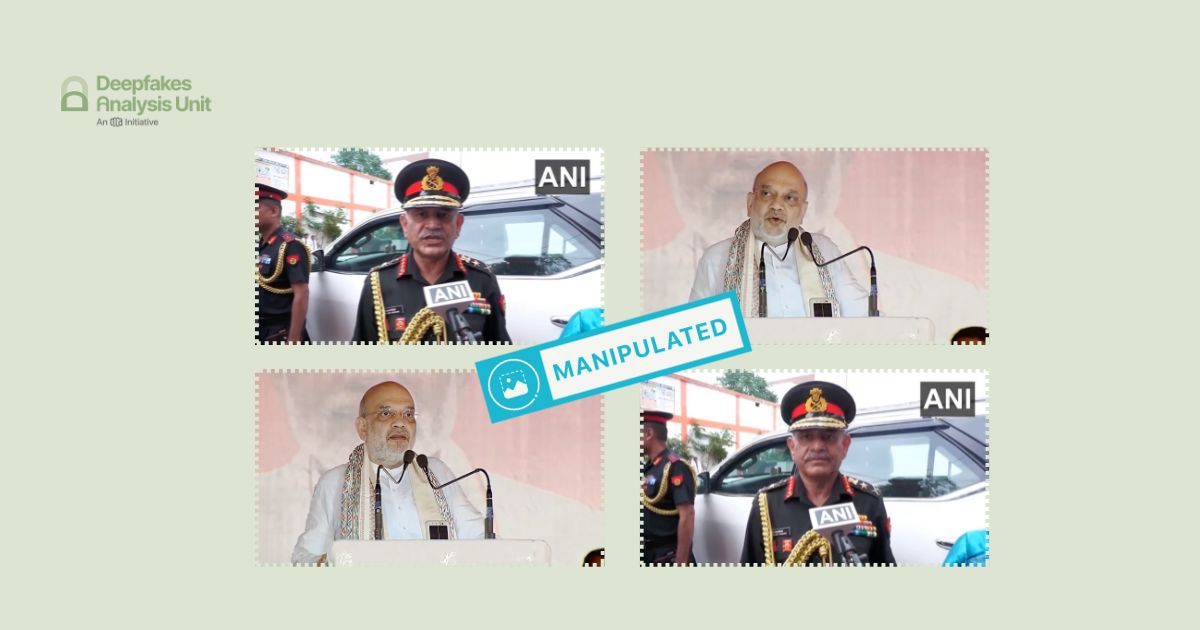The Deepfakes Analysis Unit (DAU) analysed a video that apparently shows Sundar Pichai, chief executive of Google and Alphabet, endorsing a supposed investment platform. After putting the video through A.I. detection tools and getting our expert partners to weigh in, we were able to conclude that synthetic audio was used to fabricate the video.
A Facebook link to the nearly three-minute video in Hindi was sent to the DAU tipline for assessment. The video, embedded in a post, was published on June 21, 2025 from an account with the display name of “Mizpah Ministries Inc. New Jerusalem Chu”. We would like to point out that the same account had also uploaded another video manipulated with A.I.-generated audio that we debunked recently.
The text in the post that carries the video reads: “Indian citizens only Registration is limited” with an emoji of the India flag in between. So far, the video has garnered more than 11 million views. We don’t have any evidence to suggest that the video under review originated from the aforementioned account or another.
In the video Mr. Pichai appears on a huge stage seemingly addressing a gathering of people, mostly westerners. The footage alternates between mid close-ups and long shots of Pichai, sometimes with the audience also visible in the visuals; cutaways of the audience have also been inserted in the video. In some frames, a digital projection of the Indian flag fluttering can be seen in the backdrop with the words “Quantum AI” visible in the bottom right corner of the flag.
Static text graphics in English visible at the bottom of the video frame throughout, read: “People are quitting their jobs: All because of one platform available only in India. “Followed by another line which conveys that with a minimum investment of “21,000” rupees “3.5 lakh” rupees can be earned “per month”, and it ends with the words “does it really work?”
A male voice recorded in first person in Hindi over Pichai's video track mentions his place of birth in India and states that Pichai is the leader of a top tech company, yet, has not forgotten his Indian roots. It further says that through the supposed “intelligent platform” known as "Quantum AI", which is “fully automated” and A.I.-driven, Pichai wants to pay the “debt" to his home country as it will help Indians achieve “financial freedom”.
The same voice repeats the numbers mentioned in the text graphics with regard to the supposed initial investment amount and monthly returns while adding that the purported platform can give returns worth “11,000” rupees per day. It also suggests that the registration process takes “two minutes” and that there is no prior “trading” knowledge needed to use the supposed platform, which can be accessed through a phone.
In a tone that conveys a sense of urgency, the voice asserts that the “platform is anonymous” and is meant “exclusively for Indian citizens”. It “thanks” Amit Shah, India’s Home Minister, and Nirmala Sitharaman, India’s Finance Minister, as it claims that they have supposedly lent support to the purported project. The video ends with the voice urging viewers not to “doubt” the offer as they might miss out on a “once-in-a-lifetime opportunity” and “stay where they are”; and urges them to make an “investment” and start seeing "results" as early as the next day.
Even as there is emphasis in the audio that the supposed platform is strictly available to Indian nationals and would not be made available to foreigners, the audience seems to have fewer Indians compared to westerners.
The lip movements of Pichai appear mostly in alignment with the audio in the visuals that show him in a mid close-up, however, it is difficult to discern the lip-sync in the long shots. Even as the overall video quality is not very good, Pichai’s mouth seems heavily pixelated compared to the rest of his face. His teeth look blurred in some frames, jagged in others, and a patch of off-white in a few.
The voice attributed to Pichai in the video sounds somewhat similar to his real voice as heard in his recorded videos available online. However, that delivery sounds scripted, robotic, and lacks natural pauses or changes in pitch or tone that are typical of human speech.
The Hindi heard in the video is very chaste rather than conversational. This is also peculiar as Pichai is rarely heard using Hindi while communicating, which makes it difficult to analyse his Hindi accent as there are no publicly available voice samples for comparison.
The room in which the apparent address of Pichai seems to have been recorded is packed with people and they can be seen clapping in some frames, however, no ambient sound is captured in the audio track.
We undertook a reverse image search using screenshots from the video and traced Pichai’s clips to this video published from the official YouTube channel of Google on May 20, 2025. Pichai’s clothes and body language in this video and the one we are reviewing are identical. The backdrop, however, looks different as the screen behind Pichai displays information about Google’s product updates, and a logo of Google is visible in the bottom right corner of the video frame.
The text graphics seen in the doctored video are not visible in the original video, which also features subjects other than Pichai. The audio tracks in the two videos are different and there is no mention of any income generating platform in the original audio track, which is in English and not Hindi.
This is yet another suspicious video where some “Quantum AI” platform is being mentioned. The same name has been used in several financial scam videos previously debunked by the DAU, such as here and here, which too falsely linked public personalities to dubious investment platforms. There are also similarities between the messaging, tone, and the suggested initial investment amount of 21,000 rupees.
To discern the extent of A.I. manipulation in the video under review, we put it through A.I. detection tools.
The voice tool of Hiya, a company that specialises in artificial intelligence solutions for voice safety, indicated that there is a seven percent probability of the audio track in the video having been generated or modified using A.I.

Hive AI’s deepfake video detection tool did not highlight any markers of A.I. manipulation in the video track. Their audio detection tool indicated that most of the audio track was A.I.-generated but for a 30-second segment.

For specific analysis of the audio track we ran it through the A.I. speech classifier of ElevenLabs, a company specialising in voice A.I. research and deployment. The results that returned indicated that it was “very unlikely” that the audio track used in the video was generated using their platform.
However, when we reached out to ElevenLabs for a comment on the analysis they told us that based on technical signals analysed by them they were able to confirm that the audio track in the video is synthetic or A.I.-generated. They added that they have taken action against the individuals who misused their tools to hold them accountable.
To get further analysis on the video we reached out to ConTrailsAI, a Bangalore-based startup with its own A.I. tools for detection of audio and video spoofs.
The team ran the video through audio as well as video detection models, the results that returned suggested that it is a lip-sync attack and the audio is A.I.-generated. They noted that Pichai’s lip region is blurry and his lip movements look animated. They added that the voice, despite sounding like him, has unnatural tonality and pacing.


To get another expert to weigh in on the video, we escalated it to the Global Deepfake Detection System (GODDS), a detection system set up by Northwestern University’s Security & AI Lab (NSAIL). The video was analysed by two human analysts, run through 22 deepfake detection algorithms for video analysis, and seven deepfake detection algorithms for audio analysis.
Of the 22 predictive models, seven gave a higher probability of the video being fake and the remaining 15 gave a lower probability of the video being fake. Five of the seven predictive models gave a high confidence score to the audio being fake and the remaining two models gave a low confidence score to the audio being fake.
In their report, the team echoed our observations about the voice being attributed to Pichai as they noted that it sounds atypically monotone and lacks natural tonal and cadence inflections. They also mentioned that the persistent blurring of Pichai’s face, especially around his mouth, makes it difficult to distinguish his lip movements, and that obscuring facial features could be a tactic used to hide media manipulations.
The GOODS’ team also pointed to specific time codes in the video where Pichai's eye movements seem odd as he appears to be blinking. They further highlighted subtle visual distortions or glitches that cause Pichai’s features to appear misshapen, such as, in one frame his hands seem abnormal. In conclusion, the team stated that the video is likely generated via artificial intelligence.
Based on our findings and expert analyses, we can conclude that original footage featuring Pichai was used with synthetic audio to fabricate the video in a bid to scam people through yet another fishy financial investment platform.
(Written by Debopriya Bhattacharya and Debraj Sarkar, edited by Pamposh Raina.)
Kindly Note: The manipulated audio/video files that we receive on our tipline are not embedded in our assessment reports because we do not intend to contribute to their virality.












